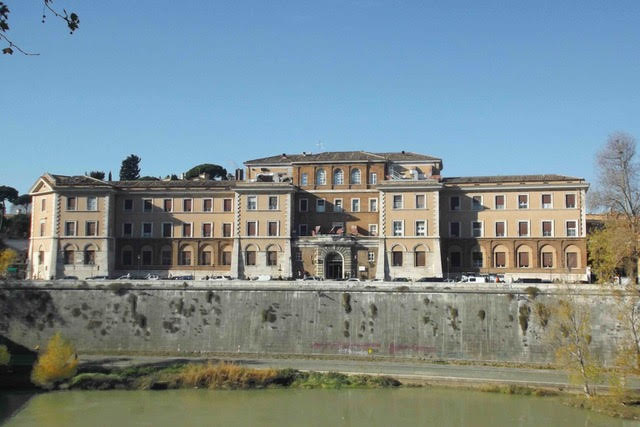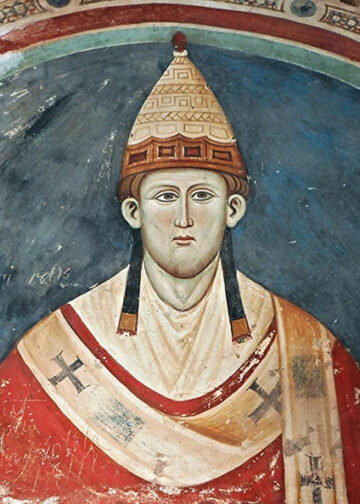On July 22, Sergio Mattarella, the President of Italy, inaugurated the reopening, after a two-year restoration, of the magnificent Renaissance “Corsie Sistine” or, “Sistine Ward” at the oldest still-functioning hospital in Europe, the complex of Santo Spirito in Saxia. The extensive work repaired the carved wooden ceiling, the masonry, the interior and exterior plaster and revived the huge expanse (13,000 square feet) of frescoes and polychrome painted wood.
The hospital on the banks of the Tiber, at only a five-minute walk from St. Peter’s Basilica, was founded in 727 by King Ina of Wessex on the ancient site of the gardens of Agrippina the Elder, the mother of Emperor Caligula. This fortified citadel was known as the Schola Saxonum because it provided accommodation and assistance to English pilgrims, including several kings, until the Norman Conquest. Afterwards Santiago de Compostela and Canterbury became even more popular pilgrim venues than Rome so the Schola gradually fell into disrepair.

Then in 1198 Innocent III, Pope from 1198 to 1216, suffered greatly from a recurring dream: fishermen on the Tiber pulled up numerous bodies of drowned babies in their nets and presented their catch to the pope. (Illegitimate, they’d been thrown into the river by their adulterous or courtesan mothers who’d wanted to cover up their sin). The dream ended with an angel commanding Innocent to build a hospice for unwanted babies, so he commissioned the sculptor/architect Marchionne D’Arezzo to rebuild the schola as a hospital for the care of abandoned infants, the sick, the poor and the homeless.
Built in one of its exterior walls is a still-visible today “wheel of the exposed”, a wooden turntable behind a little door on which unwanted infants could be placed anonymously and so subsequently cared for. In addition, on November 25th, 1198 he approved the Order of Hospitallers through the bull “Religiosam vitam” and put Guy de Montpellier, a templar knight who’d already founded several hospitals in France, under Vatican protection.

He then created a statute of rules for the Order and entrusted the Hospital’s management to Montpellier and his Order. Three years later he endowed the Hospital with considerable income; it also received numerous donations including one from the notorious John, King of England from 1199-1216. Together these covered the cost of additional buildings for the hospital.
Less than three centuries later, in 1471, the hospital was ravaged by a fire of unknown origin. Thus, it was unlike those of the 9th century during the papacy of Leo IV which had been set by Saracen marauders who’d traveled up the Tiber. Many centuries later these fires were depicted in Raphael’s fresco called “The Fire in the Borgo” (1514-17) commissioned by Pope Julius II for his apartments in the Vatican’s Apostolic Palace. Raphael’s fresco depicts Pope Leo IV putting out a fire in 847 with a benediction from a balcony in front of the old St. Peter’s Basilica.
The newly elected pope Sixtus IV (r. 1471-84) despaired of the hospital’s dark, airless ruins which he described as looking “like a place intended for captivity rather than for health recovery.” So, he ordered a full reconstruction of the facilities in anticipation of the upcoming 1475 Jubilee. The new structure, dubbed the “Corsie Sistine”, was the first example of Renaissance civic architecture built in Rome.
Surmounted by an octagonal tower, the Corsie is an immense hall, 394 feet long and 40 feet wide, divided into two spaces separated by a tower, or lantern, designed by the Florentine architect and ebonist Giovannino de’ Dolci. Under the lantern at the center of the Corsie there’s a ciborium (a canopy with four columns over an altar), probably the only Roman work by Palladio. In the past, behind the altar there was a pipe organ to give some pleasure to the ill during their stay.

Of particular beauty, hence the Corsie’s attribution as “the second Sistine Chapel” (even if it’s chronologically a bit earlier), are its frescoed walls. Painted by Melozzo da Forlì, Ghirlandaio, Pinturicchio and Antoniazzo Romano, on facing walls they depict some 50 scenes from the lives of Popes Innocent III and Sixtus IV. Their most important episodes are the drowning of illegitimate babies in the Tiber, the fishermen showing the dead babies to Pope Innocent III, his dream, and his establishing the hospital and orphanage.
It wasn’t long before hospitals built on the model of Santo Spirito Saxia sprang up all over Europe. We know that before the papacy of Innocent III there were no hospitals dedicated to the care of illegitimate children, the poor and the homeless. At the end of the 13th century the Hospitals of the Santo Spirito numbered some 100. The majority were located in Latium, but others were in Umbria (Foligno), Abruzzo, Marche, Tuscany (Florence), and the Kingdom of Naples (Pozzuoli). By the end of the 15th century there were over 1,000.
The mostly elderly patients were housed in the Corsie because this structure has a covered walkway and a small terrace where they used to sit. Sometime in the 1980s or ‘90s, the Corsie was abandoned, and during the Jubilee Year 2000 this monumental complex became a convention center that remained closed until now.
At the inauguration of its re-opening to the public, which appropriately put on exhibit 48 photographs of healthcare worldwide, President Mattarella signed the Liber fraternitatis. It’s an illuminated codex dating to 1446 and signed by most of the Hospital’s benefactors since then. Dario Franceschini, Italy’s Minister of Culture, also announced that there are many other historic hospitals in Italy slated for restoration thanks to a new initiative by his Ministry.
The entrance is free, but reservations required to visit.












